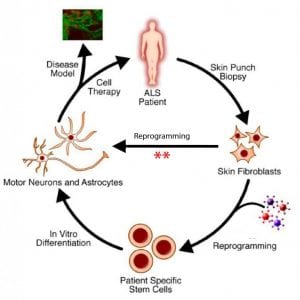Our research is focused on understanding how genetic and environmental factors contribute to human neurodegenerative disease.
The mammalian central nervous system is assembled from a diverse collection of neurons, each with its own unique properties. These discrete characteristics underlie the proper integration and function of each neuron  within the circuitry of the brain and spinal cord. However, their individual qualities also render particular neurons either resistant or sensitive to particular degenerative stimuli. Thus, for each neurodegenerative disease, a stereotyped set of neuronal subtypes is destroyed, causing the hallmark presentation of that condition.
within the circuitry of the brain and spinal cord. However, their individual qualities also render particular neurons either resistant or sensitive to particular degenerative stimuli. Thus, for each neurodegenerative disease, a stereotyped set of neuronal subtypes is destroyed, causing the hallmark presentation of that condition.
While animal models have been invaluable tools for identifying pathological mechanisms, this approach is usually limited to monogenic disease. Many common forms of disease that involve complex genetic and environmental factors cannot be addressed in this manner and remain difficult to study. Although primary human tissue could serve as an alternative, the central nervous system is usually not accessible until long after the causative events have occurred.
In order to overcome these challenges, we use cellular reprogramming and stem cell technology to build patient-specific in vitro models of neurodegenerative disease. Using precise combinations of transcription factors, small molecules and growth factors, we can convert fibroblasts from patients into disease-affected neural cells while preserving their genotypes.
This enables mechanistic investigation of both familial and sporadic forms of neurodegenerative diseases and allows experimental control over genetic and environmental factors. We use a combination of chemical genetic, biochemical and genetic tools to identify new pathological mechanisms and potential therapeutics using these models.
We are also using chemical, genetic and bioinformatic tools to better understand defined-factor reprogramming. We are interested in identifying the epigenetic and biochemical pathways that regulate cell fate conversion.
Our goals are to enable the construction of disease models that best mimic in vivo systems and to regenerate tissues and organs compromised by disease or injury.
